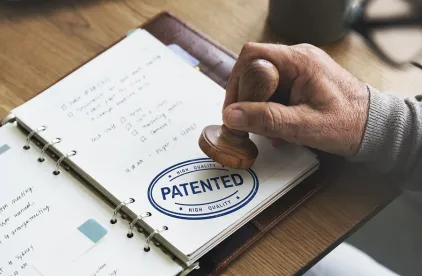In 2014, the United States Supreme Court in a landmark decision in the field of Patent Law (Alice Corp. v. CLS Int’l)1 invalidated software patents related to mitigating settlement risk. Relying on the now-infamous Section 1012, the Court held that use of an intermediary to mitigate settlement risk in a financial exchange is a fundamental economic practice directed to a patent-ineligible abstract idea.
Having broadened the notion of “abstractness” without much guidance, the Supreme Court instructed courts to review claims in a two-step process. The first step is whether the protected concept is simply an “abstract” idea. If so, the second step asks whether the claims directed to “substantially more” than what is known.
As one can imagine, courts and the Patent Office struggled with defining the breadth of these terms. The Alice decision resulted in increased challenges and difficulties in getting software and business method patent applications allowed by the United States Patent and Trademark Office. These applications are often described as assembled steps and pieces which, when combined, create a new invention but when piecemealed appear abstract. In addition, anyone accused of infringing a software and business method patent has taken the task of immediately seeking to invalidate the asserted patents in a motion to dismiss on the pleading. The Federal Circuit and other lower courts, without clear guidance from the Supreme Court, began invalidating software and business method patents at a record pace on this basis to the dismay of many.
In the Northern District of Illinois, Judge John J. Tharp, Jr., having invalidated two patents based on Alice denied fees to the victor, ironically concluding: “The only thing exceptional about this course of conduct is that O2 Media [[having had two patents invalidated]] stopped fighting sooner than it had to [[and did not appeal my decision.]]”3
However, while the Supreme Court has yet to correct the vagueness of its test and Section 101, since 2016, there have been some decisions in favor of software and business method patentees challenged under Alice. It started with the May 2016 decision in Enfish, LLC v. Microsoft Corp.4 The claims in Enfish were directed towards improved information and a data-storage retrieval system using a self-referential logical table. The Federal Circuit reversed and said “we do not read Alice to broadly hold that all improvements in computer-related technology are inherently abstract.” Following Enfish, the court decided similarly for BASCOM Global Internet Services, Inc. v. AT&T Mobility LLC.5 In BASCOM, a computer system for filtering Internet content was said to be an abstract idea of filtering content, but the ordered combination revealed it to be substantially more.
Following Enfish and BASCOM, courts started to give patent practitioners some guidance. For example, Thales Visionix Inc. v. U.S.,6 upheld patent-eligibility for claims directed to systems for inertial tracking using laws of physics—the mere presence of a mathematical equation in the solution “does not doom the claims to abstraction.” In McRo, Inc. v. Bandai Namco Games America7, the court upheld patent-eligibility for claims directed to the method of automatically animating lip synchronization and facial expression of three-dimensional characters. In Visual Memory LLC v. Nvidia Corp.8, the Government upheld patent-eligibility for claims directed to computer memory with programmable characteristics based on processor and other operational characteristics. In Finjan, Inc. v. Blue Coat Systems, Inc.9, the court upheld patent-eligibility for claims directed to a computer-implemented method of attaching a downloadable security profile to a downloadable. More recently, in Core Wireless Licensing S.A.R.L. v. LG Electronics. Inc.10, the court was asked to review claims directed towards an improved graphical user interface for mobile devices that displays commonly accessed data on the main menu. In upholding the claims as patent-eligible, the court made analogies between this invention and those found patent-eligible in Enfish, Thales Visionix Inc., Visual Memory and Finjan. These few cases are overshadowed by well over a hundred cases that upheld invalidation based on Alice. It is clear that the area of the law on software and business method patents is still evolving and the road ahead remains cluttered.
The Ray of Sunshine: Aatrix Software, Inc. v. Green Shades Software, Inc.
As noted above, motions to dismiss for failure to comply with Section 101 are filed under Rule 12(b)(6)11 at the early stages of litigation, often prior to claim construction. As a result, courts are asked to adopt claim constructions desired by the non-moving party.12 In Aatrix Software Inc. v. Green Shades Software, Inc.13, the patent holder moved for leave to amend the pleading to add factual allegations that addressed directly a Section 101 challenge. The district court denied the request to amend. The Federal Circuit, agreeing with the patent holder, reversed finding “[T]he district court granted this Rule 12(b)(6) motion without claim construction. We have some doubt about the propriety of doing so in this case, but need not reach that issue because it did err when it denied leave to amend without claim construction and in the face of factual allegations, spelled out in the proposed second amended complaint, that, if accepted as true, establish that the claimed combination contains inventive components and improves the workings of the computer.”14
In sum, we believe that Aatrix supports the idea that statements of fact which support a position that claims are not simply abstract ideas and/or are substantially more than what is known MUST be added as allegations of the Complaint. This will allow early challenges to be dismissed, pushing Alice invalidations at the normal stage of invalidation of a patent along with Section 102 and 103 challenges.
1 134 S. Ct. 2347 (2014)
2 35 U.S.C. § 101
3 O2 Media, LLC v. Narrative Science Inc., 1:15-cv-05129, Dkt. #40.
4 822 F.3d 1327 (Fed. Cir. 2016)
5 827 F.3d 1341 (Fed. Cir. 2016)
6 776 F.3d 1343 (Fed. Cir. 2017)
7 837 F.3d 1299 (Fed. Cir. 2016)
8 (Fed. Cir. 2018)
9 No. 2016-2520 (Fed. Cir. 2018)
10 __ F.3d __ (Fed Cir. 2017)
11 See, e.g., Generic Techs. Ltd. v. Merial L.L.C., 818 F.3d 1369, 1373 (Fed. Cir. 2016).
12 Aatrix Software, Inc. v. Green Shades Software, Inc., No. 2017-1452, 2018 WL 843288 (Fed. Cir. Feb. 14, 2018)
13 Id.
14 Id. at p.6



 />i
/>i

